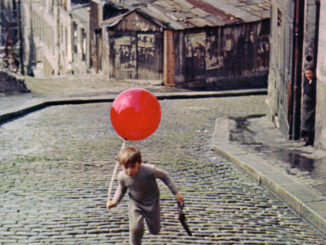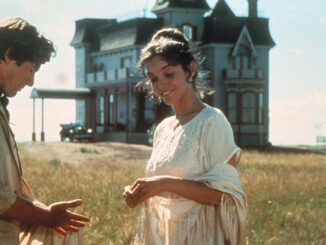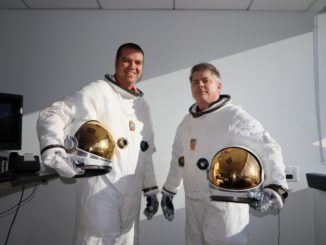
by Peter Tonguette

In 2004, after spending a decade working with Martin Scorsese and Thelma Schoonmaker, ACE, assistant editor Tom Foligno finally got his first chance to be an editor. It wasn’t in the cutting room, however, but on the big screen.
That year, Foligno was cast as an extra in Scorsese’s biopic of the publicity-averse industrialist and sometimes moviemaker Howard Hughes, The Aviator. The film — with a cast including Leonardo DiCaprio as Hughes, Cate Blanchett as Katharine Hepburn and John C. Reilly as Noah Dietrich — was honored with five Academy Awards, including Best Achievement in Film Editing for Schoonmaker.
For a memorable scene depicting the editing of Hughes’ 1930 classic, Hell’s Angels, Scorsese turned not only to bit-part players but also to several real-life veterans of his own cutting room, including the film’s first assistant editors, Foligno and Scott Brock.
“It was great because Marty thought of us right away,” remembers Foligno, who had worked as an assistant editor on five Scorsese films, beginning with Casino (1995) and ending with The Aviator. “He said, ‘I have this scene in an editing room and I want you guys.’ We also helped dress the set. They wanted our opinions on what an editing room might look like.”
The scene has the usual Scorsese blend of motion and energy. “It’s one of those classic Scorsese shots where he starts tight on an old-fashioned Moviola and then pulls back,” Foligno remembers. “It twirls around and we see the entire editing room, and it twirls around again.” The camera pauses on a female editor meticulously examining a strip of film while wearing white gloves (a cameo appearance by legendary editor Anne V. Coates, ACE) before moving onto Foligno, looking dapper in a suit with a vest. The assistant editor walks across the screen while carrying a reel of film. Soon after, an off-screen character barks out: “Pat, Mr. Hughes needs this reel in the projection room right now!”
Since Scorsese and Schoonmaker had already made the transition from film to digital editing, Foligno and his cutting room colleagues were unable to contribute splicers or tape to the set, but they did help create the picture of the “super-busy, cluttered editing room” envisioned by production designer Dante Ferretti and his wife, set decorator Francesca Lo Schiavo.
Although Foligno’s walk-on in The Aviator remains his sole screen appearance to date — “My only,” he jokes, “my absolute only” — the experience represented the culmination of the decade he spent working on the director’s films. “He had plenty of other extras,” Foligno reflects, “but he wanted to give us that opportunity to get us in the film.”
A native of New Jersey, Foligno grew up as a fan of Scorsese’s films but never imagined that he would one day work with — let alone be directed by — the master filmmaker who shares his Italian-American heritage. “I would rent VHS tapes of all his films, but the one that really hit home was Goodfellas [1990],” Foligno says. “I must have watched that a thousand times and tried to memorize every line, but I wasn’t saying, ‘I’m going to work for that guy one day.’ Not at all — it was the furthest thing from my mind.”
Foligno broke into the business in 1986, when he was hired to work in post-production at Troma Entertainment in New York City. “I had never been in an editing room, much less a full film company,” he says. “I worked for a while, then they started paying me a little bit of money.”

Miramax/Warner Bros./Photofest
While at Troma, Foligno met future assistant editor Joel Hirsch, who subsequently worked with Scorsese as an apprentice on Cape Fear (1991) and second assistant editor on The Age of Innocence (1993). By the time Casino came around, Hirsch had moved up to first assistant editor, and Foligno was brought on as second assistant. “I said, ‘If you ever have a chance to hire me in Scorsese’s cutting room, please do,’” Foligno recounts. “And he did.”
Starting with Casino, Schoonmaker and Scorsese cut their films using the Lightworks system, which the filmmakers preferred to the more widely adopted Avid. “On Avid, it’s a lot of keyboard strokes and mouse clicks,” Foligno explains. “On Lightworks, there is a controller that mimics how it would be on a flatbed system like a KEM or a Steenbeck. There were only four buttons and a little toggle that would allow you to go forward or reverse. Thelma saw the set-up of this system and it looked very familiar to her. I think that’s why she gravitated toward it instead of Avid.”
The Aviator was the first Scorsese-Schoonmaker project on which there was no film in the cutting room. “On all the films prior to that, we had worked with digital information, but we always matched back to film and projected film in a double system with sound and picture,” Foligno says. “Previously, I was on a bench, conforming film, marking up opticals and sending out requests for things. This was the first film where I didn’t have a bench, so they got me a Lightworks.”
During the production of The Aviator, the cast and crew — including the editing team — moved multiple times. Filming kicked off in Montreal before moving to Los Angeles for desert and flying scenes. Finally, the company made its way to New York, but then Scorsese changed offices, relocating from Park Avenue to his current digs at the Directors Guild of America building.
“It was stressful because you had to have everything organized,” Foligno comments. “There were a lot of tapes and other things that we had to keep track of, and make sure we didn’t leave anything anywhere. You never knew what was going to happen next or what we were going to have to do, so each day was like a fresh start.”
Despite the repeated moves, Scorsese and Schoonmaker’s process remained unchanged. To go over dailies — which sometimes accumulated during busy production periods — the director and editor sat in a screening room while Foligno operated a projector via remote control. “We had to make sure that we knew where all the takes were and on what tapes they were,” Foligno says. “We had to really map it out via time code. If he said, ‘I want to see Take 5,’ you had to get to that very quickly because his time was limited.”
Observing Scorsese scrutinizing the takes was an education in itself. “He would be editing in his mind,” Foligno recalls. “There were little, subtle things that might have just gone by you, but he would say things like, ‘I love that. See that look?’
“Thelma worked right from the first moment that we started shooting,” Foligno continues. “She assembled it, but sometimes she might cut a scene together with two or three takes of the same angle back-to-back, so Marty would look at those within the context of the scene itself and then make a final decision.”
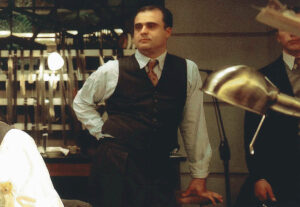
From Scorsese’s notes, Schoonmaker assembled exhaustive lists of selects. “She had books and books of selects culled from Marty’s notes to help her keep track of the footage,” Foligno remembers. “Marty had an amazing memory of what he liked, so those notes were paramount in Thelma getting what he wanted into the cut.”
Using Lightworks, Foligno also helped on temp sound effects and mixing, as well as visual effects. “In the scene where Hughes sets all his clothing on fire in his backyard and he then calls Dietrich to get him all new clothes, there’s a split screen, but Marty didn’t want a usual split screen,” Foligno says. “He wanted one that went from the top right to the bottom left, and the fire that was in Hughes’ shot had to bleed through. It was a cool effect, and I was happy that I could creatively shape that moment into what it eventually became.”
Under Schoonmaker’s supervision, Foligno, along with Brock, also helped to temp mix the soundtrack for screenings. “We would make it sound how she wanted it to sound,” he explains. “She has a fantastic ear for minute detail, and I learned a lot about music editing from her.”
Although The Aviator has a final running time of 2:50, Foligno remembers the film coming together more readily than some previous projects. “When we first cut Casino, it was three-and-a-half hours long, and after we screened it, Marty decided, ‘I want to move a bunch of stuff around.’ So we juggled a lot of scenes and reconfigured the whole thing,” Foligno recounts. “The Aviator pretty much stayed as it was after the first cut.”
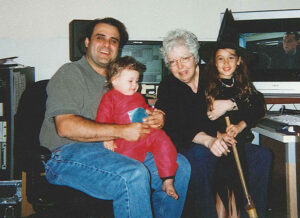
Foligno’s collaboration with Scorsese and Schoonmaker came to a close after The Aviator, but not before she had a chance to acknowledge her longtime assistant on a very public stage. During Schoonmaker’s Oscar acceptance speech, she first thanked Scorsese and the cast before expressing gratitude for the contributions of several other members of the team: “There are so many people to thank, I won’t thank them, but I think they know where they are — the mixers, the wonderful visual effects people, but particularly my assistants, Scott Brock, Tom Foligno and Erin Crackel. They really got it up there on the screen.”
Foligno was watching the broadcast at home in New York. “I couldn’t believe how generous she was in doing that,” he says. “Usually, it’s producers or directors or big executives who are thanked, but not us — not the assistants. That was really mind-blowing, and I will always be indebted to her for that.”
Foligno left the Scorsese-Schoonmaker cutting room to gain more experience on Avid, and in 2013, as big jobs in New York started to decline, he moved to Los Angeles. He is currently working on the popular HBO series Ballers (2015-present), but remains appreciative of the opportunity to work with the director he grew up revering. “You can’t imagine all the people I met just from being in his office,” Foligno says. “The Dalai Lama [the subject of 1997’s Kundun] himself came into our editing room. He was fascinated with the splicer: ‘How does that work?’ I shook the hands of Daniel Day-Lewis, Paul Newman and John F. Kennedy, Jr., to name a few, who came by the office to see Marty.”
Above all, for the lessons learned on The Aviator and other films, the assistant editor is grateful to Schoonmaker.
“She was the nicest person — gracious and fun to be with as well as being a phenomenally great editor,” Foligno says. “As I look back, it was just a great time to be there with her, doing what we were doing.”



